Tired of clothes that don’t match your style or fit the way you want? Custom clothing is more popular than ever, letting anyone create outfits that show their real self. This blog post will teach you how to design your own clothes in seven simple steps—from drawing and sewing patterns to choosing fabrics and using design software.
Fashion freedom starts here.
Key Takeaways
Custom-made clothing shows off your true style and solves common fit issues in ready-made outfits.
Begin simple—with basic items like hoodies or graphic tees—before moving on to detailed designs; software such as TUKAcad can help you create accurate patterns.
Your personal style grows from blending ideas from movies, history, and current fashion trends—mixing different periods is totally fine.
Fabric selection matters—a soft cotton tee feels great but misses the gloss silk offers, and different textures bring life to any outfit.
By 2025, fashion will lean even more into sustainability, as 66% of Gen Z shoppers are happy to spend extra for eco-friendly choices, and gender-fluid clothing gains wider appeal.
Table of Contents
Determine Your Goals
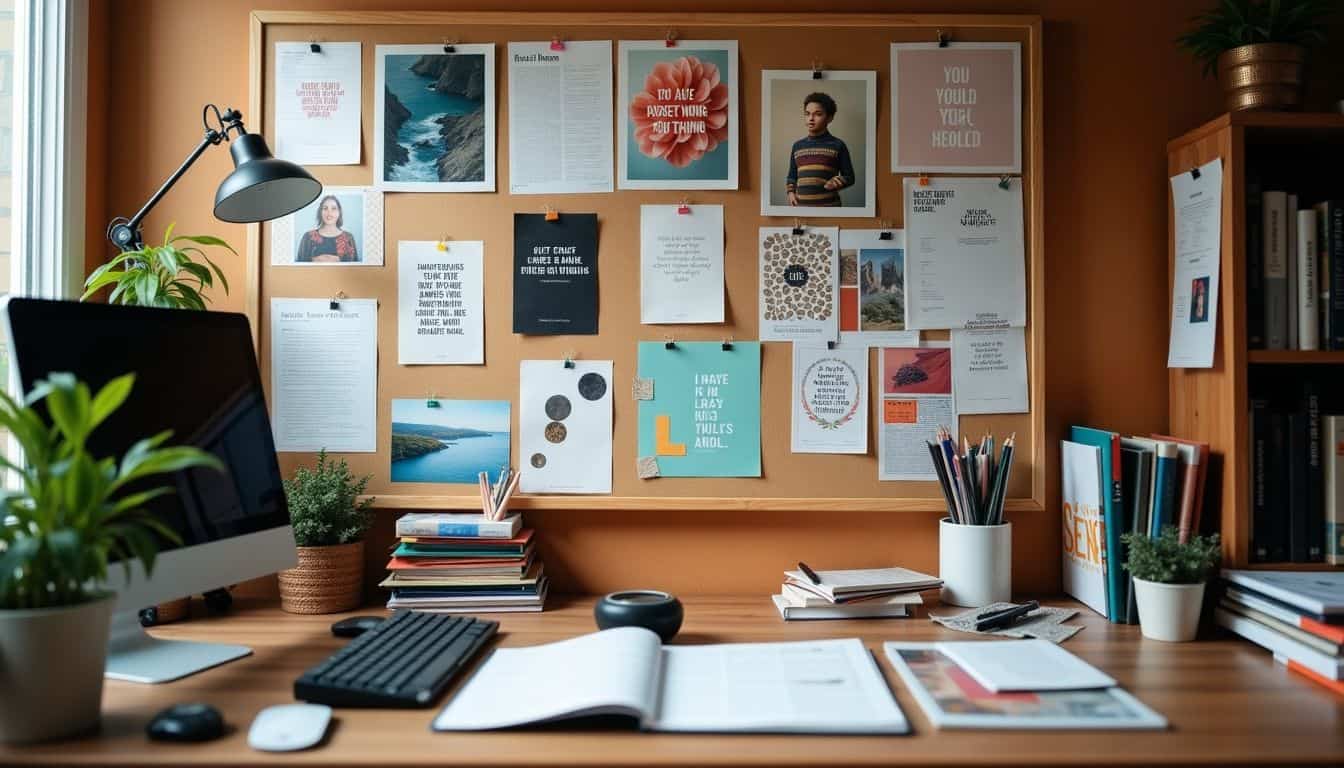
Your goals drive every choice in your design journey. Think about what you want to create – a fresh wardrobe that fits your body perfectly, or a clothing line that others will buy.
Personal Wardrobe

Building a great wardrobe means taking a real, honest look at the clothes you already have. Many guys default to basic clothing choices, missing out on a chance to truly express their style.
For a long time, I wore the same dull t-shirts everywhere—until I discovered clothing design. Learning to create my own clothes freed me from typical, mass-produced fashion found at every store.
Experts in apparel mock-ups at Yellow Images suggest starting out with easy-to-try items, like hoodies and tees.
After getting comfortable with the basics, experimenting with more advanced pieces becomes easier.
Fashion gives men the freedom to express themselves without saying a word.
Perfecting pattern making skills forms the core of creating great custom clothing. A practical hardcover guide from 2001—320 pages long—clearly explains steps for men to craft garments matching their exact shape.
A lot of men face uncomfortable fits from store-bought pieces; custom-made clothing fixes that. With computer design tools, even total beginners can easily create accurate patterns based on their real measurements.
Launching a Fashion Line

Launching a clothing brand takes careful planning and upfront cash. You’ll need money for product creation, marketing, and getting your online store running smoothly. To save costs, many guys use print-on-demand services instead of making every product themselves.
This strategy worked great for me when I started my t-shirt brand last year.
Before anything else, identify the exact group of men who will buy your designs. Once you know your customer, create a detailed business plan—with clear goals, funding sources, production details, pricing strategy, and specific marketing tactics.
Market research isn’t only for big companies—I spent weeks checking out the styles guys around my city actually wanted to wear. Successful fashion designers do more than create attractive clothes; they figure out the clothing needs their customers have, and help solve them through design.
A well-done plan outlines not just budgets and production, but also how you’ll stand out from competitors. After you’ve got the essentials mapped out, focus on crafting a unique fashion style that people will instantly recognize as yours.
Establish Your Unique Style

Your style sets you apart from other designers in a crowded fashion world. Look at movies, art, and street fashion to spark ideas that match your personal taste.
Get Inspiration from History, Film, and Trends
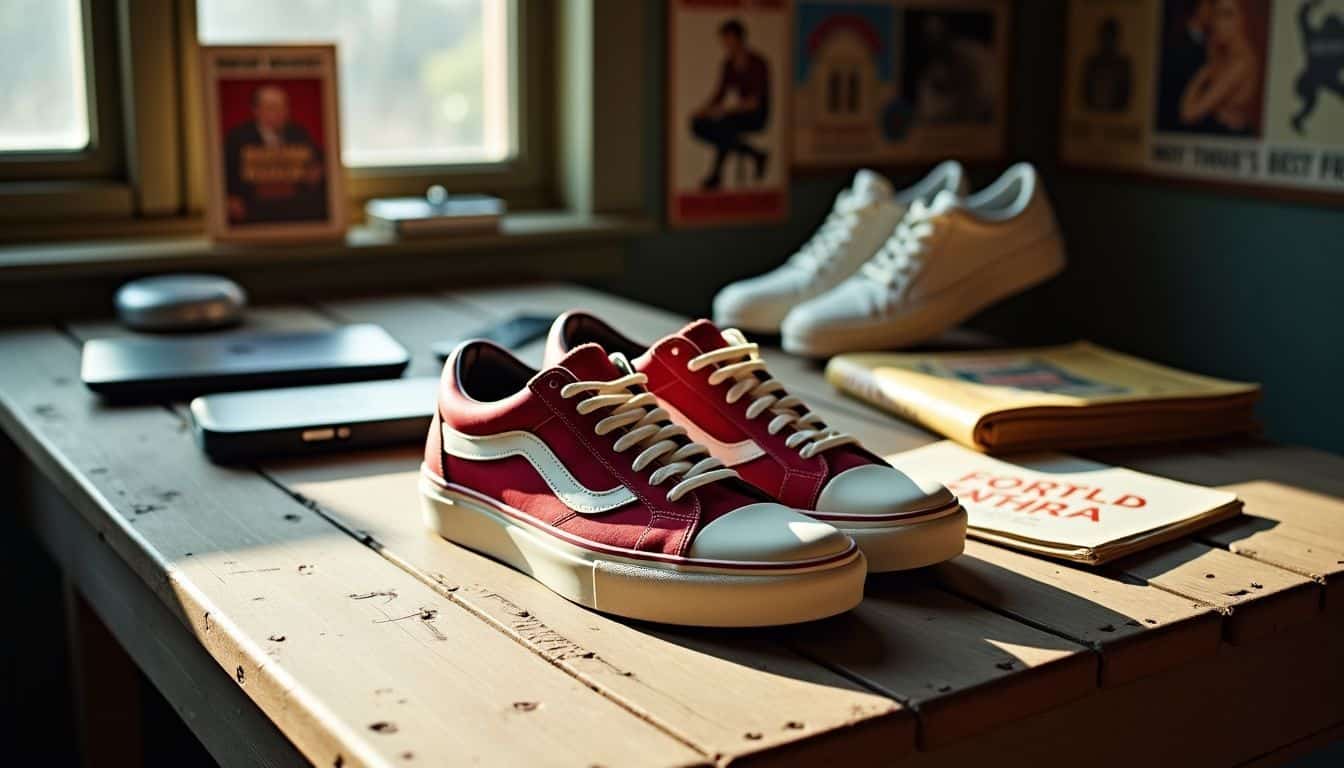
Fashion pulls inspiration from both past eras and current trends. You can find style cues in classic films—James Dean’s rebellious charm or Steve McQueen’s effortless cool still sparks creative ideas today.
Pop culture celebrities give fresh inspiration, too, especially for hoodie mockups or men’s casual styles. Glance through fashion magazines, or check online boutiques, to discover what’s trending with cut-and-sew details.
Many new designs cleverly blend old and modern elements—like a blouse in a sleek, current cut featuring vintage prints.
Style is a way to say who you are without having to speak.
Often, historical fashions return with a fresh spin. The clean silhouettes of the 1950s or bold colors of the 1970s might inspire sneaker designs or help shape your ideas for timeless fashion.
Films demonstrate how clothing reveals personality and moods. Feel free to combine patterns from multiple periods, mixing them into something completely your own. Personal style creates identity, as your clothes clearly express who you really are.
Learn Essential Skills

Learning to draw, sketch, and sew forms the backbone of your fashion design journey – grab a pencil and some fabric to start building these skills right away!
Drawing and Sketching

Fashion illustration is the foundation of your entire design process. Mastering the 9-head figure helps you sketch designs accurately, with proper proportions. It lets you show essential details clearly—like how long a hoodie falls, or how an A-line skirt fits.
Many folks skip this step, especially men, but your sketches don’t have to be perfect. The key is getting your ideas across.
Start simply: basic shapes first, then clothing details. Don’t stress too much about anatomy—just capture your vision clearly. Highlight the unique features of your pieces with color, texture, and shading.
Small additions make your designs feel alive and real. Lines showing fabric movement make a big difference, too, especially for garments like cut-and-sew shirts and dresses.
If hand-drawing isn’t your strength, use computer-aided design (CAD) software to help out. Knowing the basics of fashion sketching keeps you in control creatively. Plenty of designers got their start from simple drawings before crafting their standout collections.
Pattern-Making and Sewing
Pattern making turns your clothing ideas into wearable pieces. It’s the essential skill for bringing your fashion vision to life, helping you craft clothes you can wear or even offer for sale.
A great starting point for guys looking to learn is “How to Make Sewing Patterns” (ISBN-13: 978-0932538000). Published back in 1977 by Blue Feather Products, this handy guide contains 190 pages of practical advice and measures 8.25 x 10.75 inches—which fits nicely on your workspace.
The best designs come from understanding how fabric transforms from flat patterns into three-dimensional forms that express your personal style.
Sewing brings patterns into reality through simple cut-and-sew techniques. You don’t need extensive sewing experience to start—basic stitching skills are enough. Men’s clothing projects range from easy-to-make hoodies to detailed pieces featuring interesting textures and designs.
Your fabric choices, colors, and little touches of creativity make your style unique. It helps to begin with paper patterns, then shift to digital tools for accuracy and detailed adjustments.
Use Design Tools and Software

Modern design apps like Tukatech can turn your fashion ideas into real patterns with just a few clicks—check out our guide to learn which software fits your style and budget.
CAD for Fashion Design
CAD for Fashion Design is a handy guide for guys looking to create their own clothing without needing strong drawing skills. Published in 1997, this paperback runs 174 pages and measures 8.75 by 11 inches.
Despite weighing barely over a pound, it delivers powerful design methods in clear, straightforward steps. Personally, I began with simple t-shirt designs, but soon after, tackled more challenging hoodie mockups.
For any man who wants to skip sketching by hand, this book makes digital fashion design accessible from the start.
Software tools like Tukatech let you create patterns directly on your screen—not on paper. You can experiment with various fabric options and colors digitally before cutting real cloth.
Men in fashion frequently use these digital methods for designing casual sneakers, formal outfits, and every style in between. Taking this digital route saves time and reduces waste, since you can adjust patterns easily onscreen.
Your designs move smoothly from the computer to finished clothing, making fewer errors along the way.
Popular Design Software like Tukatech
TUKAcad makes a splash in fashion design as the go-to tool for guys creating their own clothing. This powerful CAD software gives you easy-to-use 2D and 3D features, quickly turning your ideas into ready-to-go patterns.
I gave their 14-day free trial a spin last month—definitely worth it—and created precise patterns for hoodies and casual cut and sew projects. The software reduces fabric waste while giving you exact measurements, way better than I could manage with hand-drawn sketches.
Good design is not just what it looks like and feels like. Good design is how it works.
Using smart design tools like TUKAcad saves hours of guesswork and frustration. You can tweak patterns in a few clicks, instead of redoing everything from scratch each time. Plus, previewing how various fabrics drape on a digital model helps you choose the right materials, all before cutting a single yard of fabric.
Beginners can easily jump into designing clothes without years spent training as a pattern maker or sewer. Now that you’ve got great software in hand, it’s time to dig into fabrics and colors for your styles.
Experiment with Fabrics and Colors
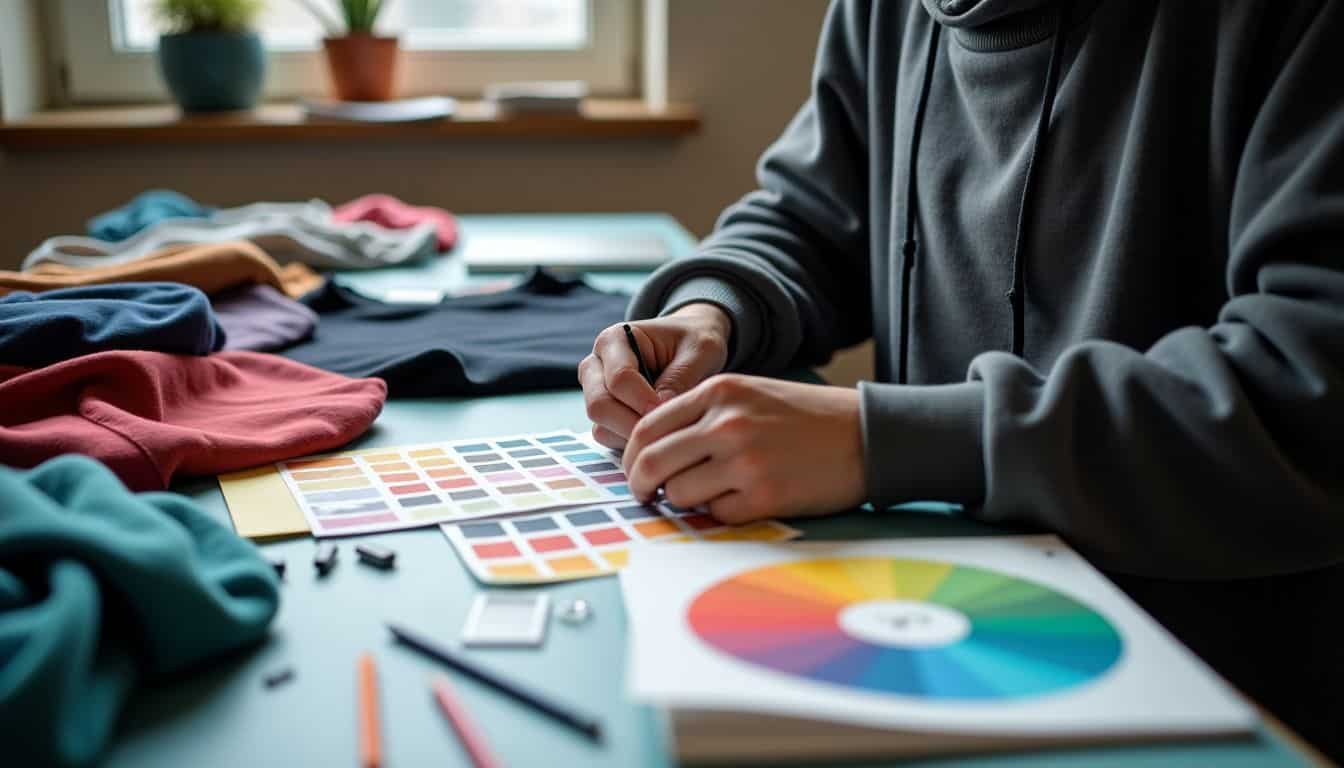
Picking the right fabrics and colors can make or break your custom hoodie designs – grab some fabric swatches, play with color wheels, and test how different materials feel against your skin before you commit to your final choices…
Explore Color Theory
Colors can shape or destroy your fashion designs. The color wheel, first created by Sir Isaac Newton, helps designers mix shades in thoughtful ways. Red, yellow, and blue form the foundation of every other shade you’ll use in your hoodies mockup.
I learned this lesson early, creating my first collection—poor color choices ruined even great patterns.
Most men overlook color theory, yet applying it gives fashion clothing a distinct advantage over typical women’s wear. Try color schemes that fit the season—deep blues in winter or vibrant yellows in summer.
Doing this makes your designs look effortlessly trendy and natural. Thoughtful color combinations also make fabric selections appear far more professional as you dress more masculine.
Once comfortable with colors, explore textures and fabric types to express your fashion vision fully.
Understand Textures and Fabric Types
Fabric choice can make or break any design—you wouldn’t believe how true this turned out, while working on my first hoodie mockup. Cotton feels soft and comfy on the skin, but it doesn’t have silk’s gentle shine.
Leather offers strength and a luxurious look, though it costs more than regular cotton. Your fabric picks should reflect the overall style and goal of your clothing. Men’s clothing often relies on fabrics like wool, denim, linen, or cotton blends for both comfort and practical use.
Every fabric moves differently, draping the body in its own unique way.
Adding texture can give your design extra depth—smooth materials like satin create sleek, clean lines, while quilted or textured fabrics bring some added dimension. Skilled pattern cutters understand that the weight and thickness of fabric really shape how clothing hangs.
Fashion designers often use texture rendering, sketching out how different fabrics look and behave. Try touching and feeling fabrics directly at the store before buying anything online—this practical approach taught me far more than any textbook ever did.
Even if your clothing sketches look amazing on paper, choosing the right fabric makes them come alive, especially for an online shop.
Create Your First Collection
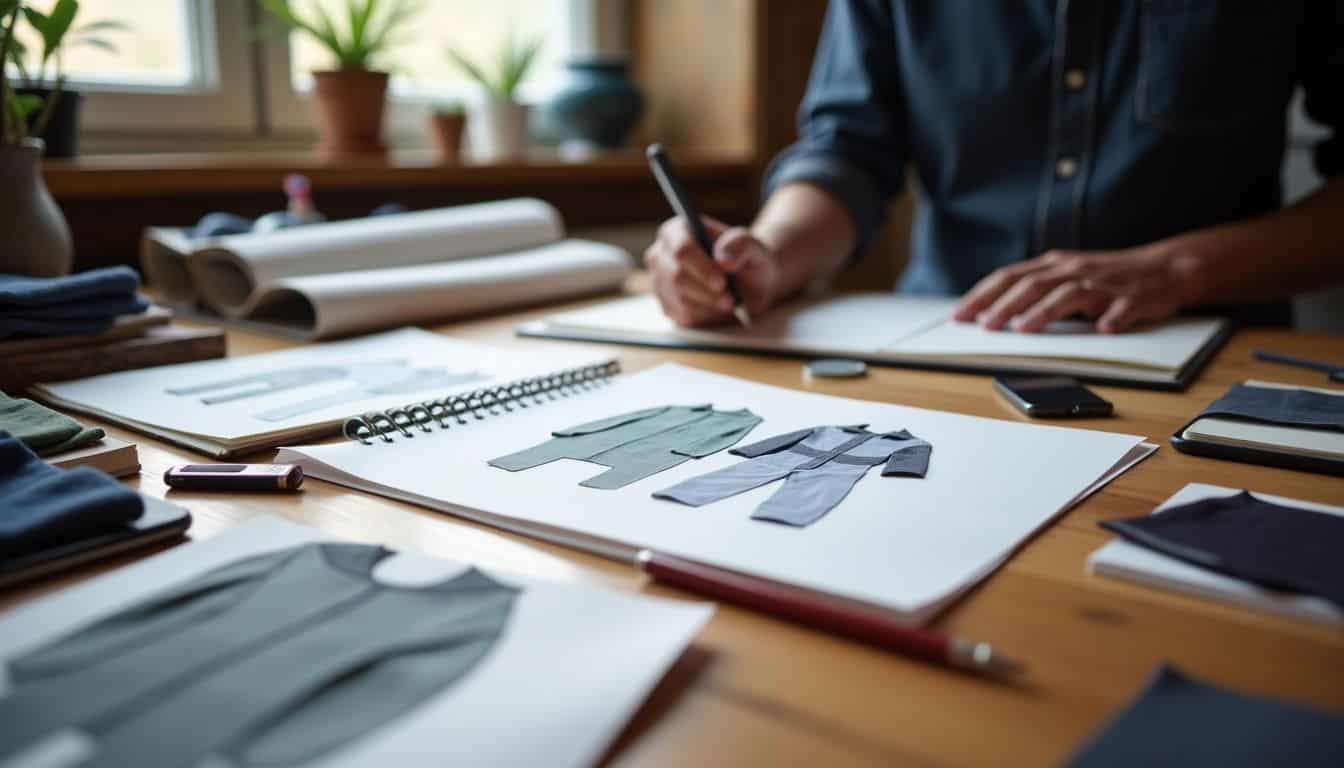
Creating your first clothing collection lets you build a small set of pieces that work together while showing off your unique style – read on to learn how to start with simple items and add your own special touches!
Start with Basic Pieces
Essential basics make up the core of any men’s clothing line. T-shirts, jeans, and button-down shirts form your foundation and offer room to grow. These simple items allow you to build confidence and develop skills without tackling tricky patterns first.
Begin your designs using quality materials that hold up over extended wear and multiple washes. Soft cotton blends are ideal for shirts, while sturdy denim is perfect for pants.
Choose garments that fit your overall theme yet leave plenty of room for creativity. Most popular fashion trends begin as straightforward cuts, later enhanced with personal details.
For instance, a plain hoodie mockup can become unique with special stitching or textured fabric panels. The fashion industry appreciates designers who skillfully handle basics first, long before moving into challenging styles like complex women’s apparel.
Start your journey small, master a few key items thoroughly, and then steadily grow your brand.
Add Custom Elements
Custom details transform basic clothing into something uniquely yours. Consider adding patches, one-of-a-kind buttons, or colorful contrast stitching for standout style. For many men, subtle elements such as custom pockets and surprising fabric sections work best.
You might even stitch a hidden message inside the collar—or maybe attach distinct trim on sleeve edges. Small alterations like these require no advanced skills, yet yield impressive results.
Your fabric selections also play a major role in customization. Combine textures for extra appeal—denim alongside canvas, or wool blended with cotton can provide fresh visual interest.
Some men favor practical elements, like hidden phone compartments or reinforced stitching at key stress areas. Style desires and real-life needs can both inspire your choices. Personal details like this can easily lift basic mockup hoodies into unique garments that show off your personality.
Finalize and Produce Your Designs
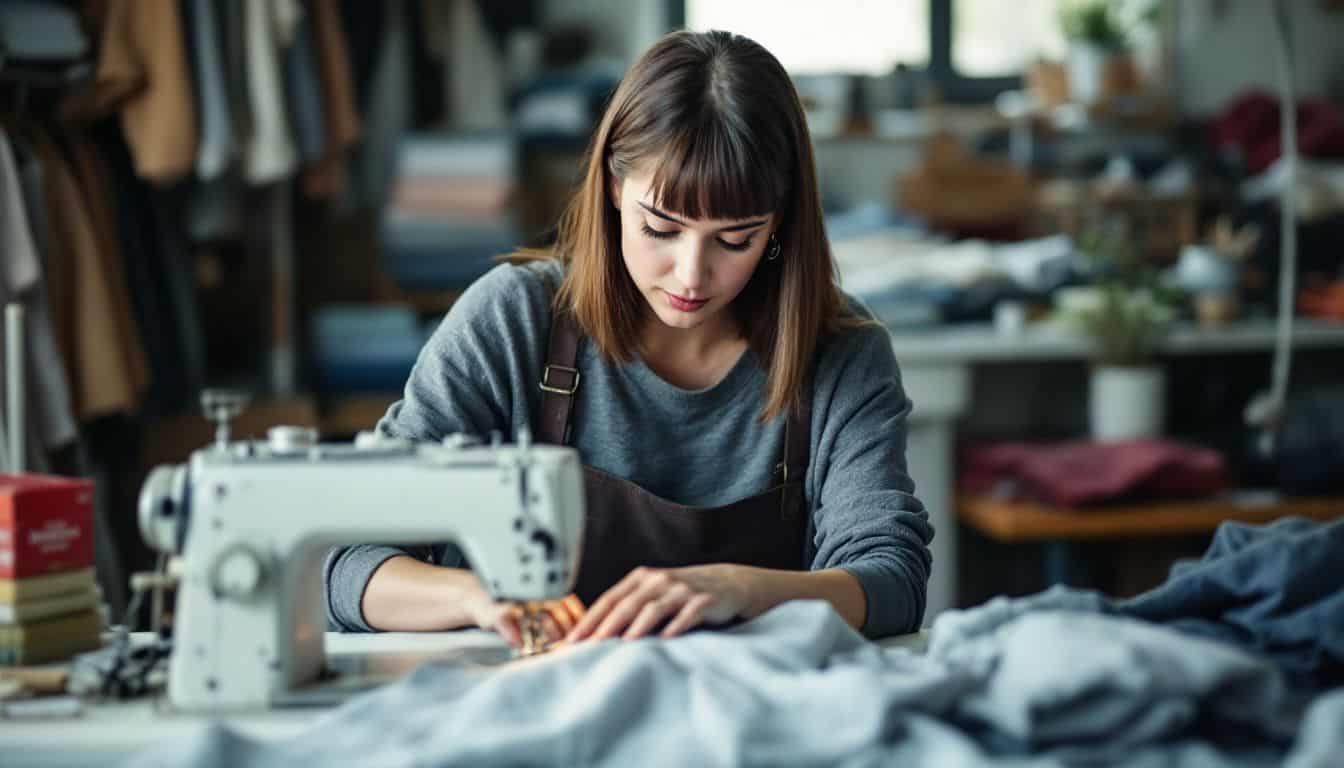
Bringing your clothing designs to life is the exciting final step. At this stage, clarity, planning, and careful communication are key.
- Double-check your tech pack closely, confirming all measurements, details, and instructions clearly before production kicks off.
- Do a final check on your fabric selections, ensuring they align with your original ideas and suit the garment you’re creating.
- Create one last prototype or sample, testing for comfort, accurate fit, and your intended style—before committing to full production.
- Snap clear, detailed photos of the design from every angle possible; these pictures help guide your manufacturer or seamstress.
- Connect with reliable and trustworthy suppliers for fabric, buttons, zippers, threads, and any other material your women’s clothing line requires.
- Partner with an experienced production team or seamstress familiar with your goals, who can reliably produce high-quality pieces.
- Clearly define timelines for each production phase so everything stays organized and moves forward smoothly.
- Carefully manage your budget for everything—from fabric costs and manufacturing labor to shipping fees if you’re planning to sell through platforms like Amazon Prime.
- Compile a simple but thorough quality-check list, inspecting finished garments carefully, before sending them to customers.
- Plan attractive and protective packaging for shipment, creating an enjoyable unboxing experience for your buyers.
How Will Fashion Design Transform in 2025?

Fashion design will see big changes by 2025—with Gen Z leading this shift. Young adults now push strongly for eco-friendly fashion; roughly 66% say they’re willing to spend more on sustainable clothing.
This attitude opens fresh opportunities for men eager to try making clothes themselves. The strong return of 90s and early 2000s fashion offers ideal inspiration. Men interested in sewing can mix vintage elements with modern touches to craft truly unique pieces.
Another major trend on the rise is gender-fluid fashion, breaking traditional clothing rules. Amazon reports more customers searching styles outside typical gender lines. This shift allows male designers to explore brighter colors, softer fabrics, and new shapes traditionally seen in women’s clothing.
For quick inspiration or fresh ideas, browse fashion images on Shutterstock or sign up for style-focused newsletters. Even a basic sewing project like crafting an A-line skirt can sharpen your skills and open the door to more creative outfits.
People Also Ask
How do I begin designing my own women’s clothing?
First, find styles you enjoy—browse fashion magazines and websites for inspiration. Sketch out your ideas, even if they’re basic. A good starting point is a simple item like an A-line skirt, easy to draw and sew at home.
Do I need special training to design clothes?
You don’t need formal training to get started! Lots of successful fashion designers began by just experimenting at home. You can learn the basics through online tutorials, Kindle ebooks from Amazon, or simply pulling apart old clothing to study stitching patterns.
What basic supplies should I have to start designing women’s fashion?
Gather sketch paper, measuring tape, fabric, and some basic sewing supplies. Begin with smaller, easier projects first—no need to buy lots of pricey tools right away.
How can I keep up with current fashion design trends?
Sign up for fashion newsletters to get fresh inspiration sent right to your inbox. Many popular newsletters provide free email updates filled with the latest women’s fashion trends, helping you stay creative and informed.
References
https://www.amazon.com/10-Steps-Fashion-Freedom-Discover/dp/060960645X
https://www.gelato.com/blog/how-to-start-a-clothing-brand
https://www.futurelearn.com/info/blog/how-to-find-your-personal-style
https://www.upskillist.com/blog/how-to-draw-fashion-sketches-a-step-by-step-guide-for-beginners/
https://www.istitutomarangonimiami.com/blog/how-to-perfect-your-fashion-sketches/ (2023-03-17)
https://www.amazon.com/Make-Sewing-Patterns-Donald-McCunn/dp/0932538002
https://www.amazon.com/Fashion-Design-Renee-Weiss-Chase/dp/0133732428
https://www.dishafashioninstitute.com/color-theory-in-fashion-design
https://fashionillustrationtribe.com/texture-surface-rendering/
https://ir.library.oregonstate.edu/downloads/6t053g25t
https://fashionandillustration.com/en/how-to-create-a-fashion-collection/
https://www.pointsofmeasure.com/tutorials-education/the-design-process-in-9-simple-steps
https://www.printful.com/blog/gen-z-fashion
https://www.appnova.com/future-fashion-trend-predictions-what-will-clothes-look-like-in-100-years/

